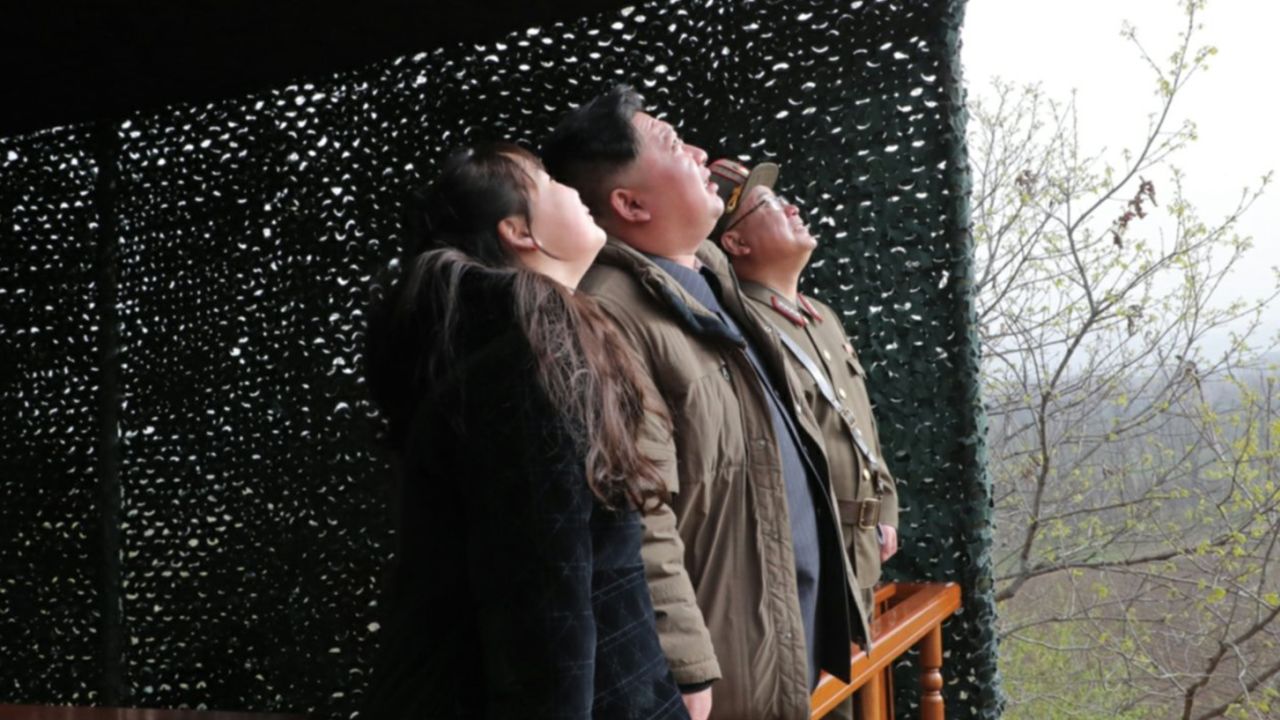The new missile, called the Hwasong-18, was launched just after 7 a.m. Thursday, triggering a brief evacuation order on the northern Japanese island of Hokkaido before it fell into the waters east of the Korean Peninsula.
State-run Korean Central News Agency (KCNA) reported Friday the missile launch, attended by leader Kim Jong Un and his daughter, “would serve as a powerful strategic attack means of greater military efficiency.”
KCNA quoted Kim as saying the Hwasong-18 would “radically promote” his county’s ability to launch a nuclear counterstrike to suppress invasions and protect the nation.
Analysts noted that North Korea already has that ability, though the new missile may enhance it.
“I think it demonstrates technological progress, but I would not describe this as a game changer,” said Ankit Panda, a nuclear policy expert at the Carnegie Endowment for International Peace.
South Korea’s Defense Ministry said Friday Pyongyang still needs “more time and effort to successfully complete its solid-fuel intercontinental ballistic missile technology.”

Kim Jong Un, center, and his daughter, left, watch Thursday’s missile launch in a photo released by state media.Courtesy Rodong Sinmun
Thursday’s missile test was North Korea’s 12th of the year, according to CNN’s count, and it came after United States and South Korean forces had earlier this month concluded their biggest military drills in years, including a large amphibious landing exercise.
It also came just days after a key meeting of North Korea’s Central Military Commission on Monday, when Kim stressed the need to quickly expand Pyongyang’s nuclear deterrence in response to “the ever-worsening security on the Korean Peninsula,” according to KCNA.
The testing of a solid-fueled ICBM is important because they’re more stable than the liquid-fueled ones that North Korea has previously tested on long-range missile launches.
A solid-fueled ICBM would be fueled during manufacturing and can be moved more easily to avoid detection before a launch that can be initiated in a matter of minutes, according to Joseph Dempsey, a research associate at the International Institute for Strategic Studies.
A liquid-fueled ICBM would need to undergo a fueling process at its launch site that could take hours, giving time for an adversary to detect and neutralize it, Dempsey wrote in an analysis earlier this year.
Explained: How much damage can North Korea’s weapons do?
02:53 – Source: CNN
North Korea reaches world standard
Thursday’s launch came as no surprise to analysts who noted that North Korea had publicized a test of a solid-fueled rocket engine in December.
Kim has wanted to bring his forces up to the standards of other nations with ICBMs after starting out with easier-to-master liquid-fuel technology – and the apparent success of the solid-fueled ICBM launch suggests his missile program is advancing.

North Korea says it launched a new type of Hwasong-18 intercontinental ballistic missile using solid fuel, on Thursday.Courtesy Rodong Sinmun
“At an earlier stage of North Korea’s missile program, liquid-fuel ICBMs represented the quickest and easiest path to achieving the country’s historic goal of being able to threaten the continental United States,” the IISS’ Dempsey wrote.
“The addition of solid-fuel ICBMs to the missile force would make it a more credible strategic deterrent by providing a more capable, less vulnerable pre-emptive and retaliatory capability,” Dempsey wrote.
The new Hwasong-18 has three stages, according to KCNA, just like the United States’ main ICBM, the Minuteman III, which is powered by three solid-fueled rocket motors.
Jeffrey Lewis, an analyst at the James Martin Center for Nonproliferation Studies, said on Twitter that it was “no surprise” a solid-fueled ICBM wasted tested by North Korea, saying “it’s just easier to use solid-fuel missiles.
“North Korea was always going to follow the same technical path as the US, Soviet Union, France, China, Israel and India,” he added. “Given that North Korea has been testing large diameter solid rocket motors for … several years, it’s been clear (to me at least) that since 2020 a test like this could have come at any time.”
Questions about reentry technology
Even with Thursday’s test, some doubt remains as to whether a North Korean ICBM could actually deliver a nuclear warhead at a long distance, for instance to the mainland United States.
Thursday’s test, like earlier North Korean ICBM tests, was fired at highly lofted trajectory, with the missile falling into waters between the Korean Peninsula and Japan. To cover the longer distance to the mainland US, an ICBM launched from North Korea would have to be launched at a much flatter trajectory.
ICBMs are fired into space, where they speed along outside Earth’s atmosphere before their payloads – nuclear warheads – undergo a fiery reentry process, much like a space shuttle or space capsule, before plunging down on their targets.
If the process of reentering the atmosphere isn’t executed with pinpoint accuracy and with materials that can withstand the immense heat generated, the warhead would burn up before reaching its target. Reentering the atmosphere at a shallow angle that would be needed on a long-range strike can make the process more difficult.
Panda, the Carnegie expert, said North Korea acknowledges that its lofted ICBM launches do not test reentry technology. But he said Pyongyang likely has the ability to master it.
“Based on their competency with materials and engineering that we’ve seen in other areas, developing a robust enough reentry vehicle is not a substantial technical challenge,” he said.
For Thursday’s test, KCNA said the highly lofted angle was used to prevent debris from posing a danger to other countries.
On Thursday, the launch sparked momentary panic on the Japanese northern island of Hokkaido after the government’s emergency alert system warned residents to take cover. The warning was soon lifted.
Soon after, fear turned into anger and confusion amid reports that the evacuation order had been sent in error, with local officials saying there was no possibility of the missile hitting the island, and Tokyo later confirming it had fallen outside Japanese territory, in waters off the east coast of the Korean Peninsula.
Source: CNN



